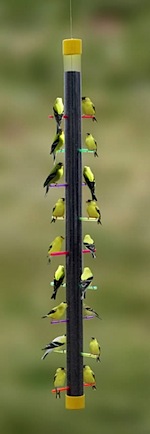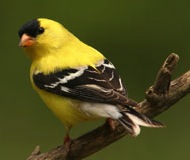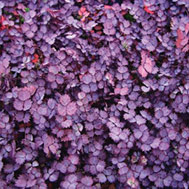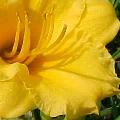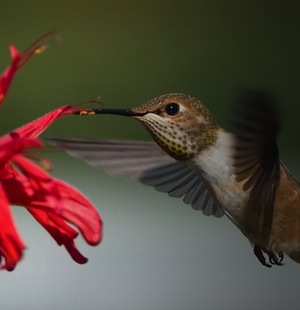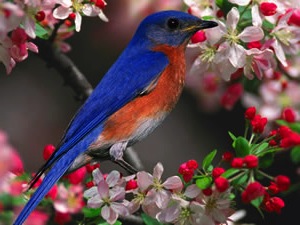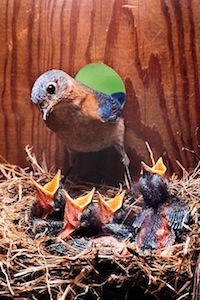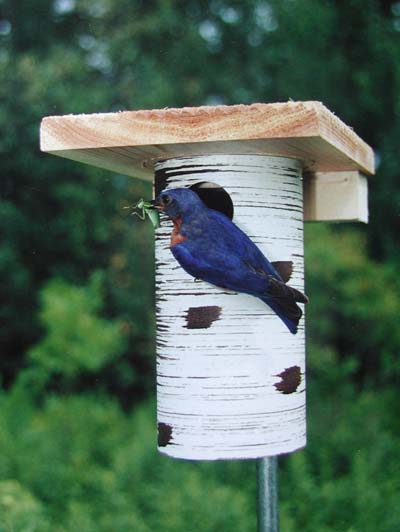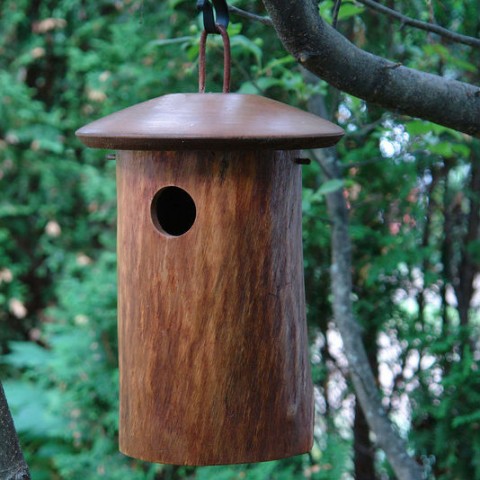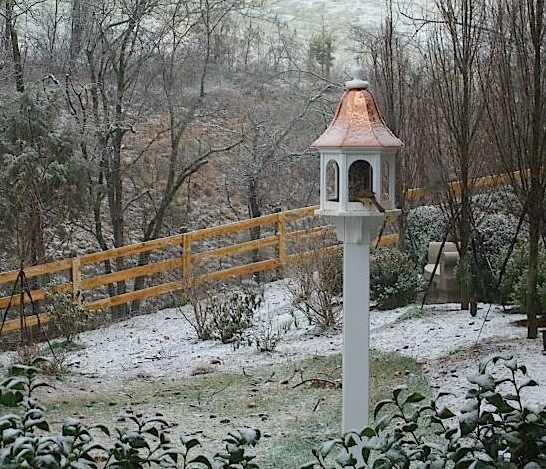-
new experience with thistle feeders
“We are just learning about the appetites of the finches.
We are already out of thistle !!! But what fun !! Jan”Recently some folks in Alexandria, LA developed an interest in backyard birding. Diving right in with a suet feeder, hopper style feeder for sunflower seed, a bird bath with mister (for summer) and two thistle feeders, the timing couldn’t have been better – for the birds and for them to witness the amazing flurry of activity this pre-spring season.
By her note above, we’re gathering they’ve got flocks of pine siskins and goldfinches in the yard right now, we sure do here in North GA.! For months thistle feeders sat, with seed going bad due to lack of activity. Then out of nowhere… tons of birds chowing down on thistle!
Also called Nyjer, thistle’s other nickname among many is “black gold” because it’s not a cheap seed to offer. A bit on the pricey side, it does have the benefit of being a non-germinating seed, one of very few seeds that won’t sprout weeds. But it’s about the only food adults will feed chicks in summer, so extra feeders (like thistle socks) and lots of seed greatly helps goldfinches thrive and flourish during their late breeding season (June and July).
Being new to the birding scene, Jan had the right idea in mind when she inquired about creating a welcoming and bird-friendly habitat in their yard. No single feeder, house, or birdbath will attract as many song birds as an overall habitat with natural food sources and shelter. And since we’re in the same planting zone, it was fairly easy to come up with a few suggestions too. Rather than re-word, and re-type the email, here’s our thoughts on cre
ating an attractive and wildlife-friendly environment.
“OK, did some research and thinking of my own yard… here are some suggestions:
Overall: Mature trees and Shrubs are very good for attracting all winged friends as not only a food source, but shelter. Since this is an open area, I’m thinking your yard must have mature trees along the back/sides? Many birds nest in trees and shrubs as they’re not all considered “cavity-dwellers” (birdhouse users).
If you’d like some kind of height or focal point around the new area, Butterfly Bush, Viburnum, Mimosa, or a Crab Apple is a great choice. These are hearty, and provide both shelter and food (nectar or fruit). Any of the native berry-producing shrubs will also provide a great food source.
Using pots for annuals is always a great option too, for color, nectar and seeds in fall!
Petunias, Zinnias, and various salvias; most garden center plants now have tags depicting if the plants provide a food source, so just look around. There should be lots of options here! You can even save seeds in the fall for replanting in spring.Cardinals, chick
adees, finches and titmice will eat seeds of many plants. The trick is not to dead-head them in fall when the urge strikes! There are lots of perennials that fit the bill in this category: coneflower, coreopsis, seedum, black-eyed susan, goldenrod, sunflowers, mexican sunflower, native salvia-(very good), coral bells,. Again look around at the garden center, and if you’re lucky… you’ll find an employee with some knowledge on the subject!
As far as for ground cover: I think mulching the area and adding plants is a better option than a solid ground cover. You’ll want to be able to get to the feeders, bath, mister and “parts” of the landscape without stepping all over things. Also, spilled seed may sprout weeds, and it’s easier to control that if not covered solid with growth.
Day lilies are a good choice, the Stella de Oro’s are quite hearty and pretty! If you wanted something more low-growing that spreads, (full sun) try purple sheep’s burr, also called purple goose leaf. In fact this would be a beautiful contrast with yellow lilies! The Stella variety tends to stay more compact as opposed to some which grow taller and appear “lanky”. Never, ever plant creeping strawberry, or ivy…these are the bane of my existence in parts of my yard 🙁 They are also a wonderful habitat for snakes, especially if you’ll have the mister going when it’s warm!
Native salvia: I’ve got a bed of this which provides color from spring through fall. Vibrant red, there are always
hummingbirds and butterflies hovering. It’s actually below one of the misters, and does well with the “extra water”. Extremely hearty, it multiplies each year, spreading roots, but does tend to grow taller, more of a back-drop. Lantana would also be a good choice if you’ve got the space for it to grow. I love perennials!
It may be helpful to actually sketch out the area on paper before planting. Drop in the plant names to get an idea. You can always do search for pics to get an idea too!
Okay… hope this helps, and as always, feel free to ping me back with questions”
-
It’s time to prep bluebird houses for nesting!
Although some days it doesn’t feel like it, spring is just about here. Buds forming on trees are beginning to unfold, while spring bulbs continue sprouting their deep green foliage. In the Southeast, many bluebirds never left for the winter. With accommodations like ours… why would they? Several heated baths and live mealworms fed daily are a pretty good gig for them.
Nest one spotted in the Gilbertson yesterday, and lots of wing-tipping and clamoring over other bluebird houses on the property. This is a good sign that actual egg-laying isn’t too far off. The wing-tipping is a hoot to watch, it’s the male who does this to attract a mate. Each time he waves a wing as if to say “hey… look at me over here, and look at this great nest box!”
Prior to winter, pine shavings were added to all birdhouses around the property. Providing warmth and a decent roost for cold nights and wet freezing days too – the shavings were removed two weeks ago. Each house was inspected for breakage, cracks and squirrel damage. Two metal portals were added to entrances where squirrels had enlarged the hole to gain access. Little boogers even got their own house last fall! Many times you can salvage bluebird houses or any birdhouse where squirrels have chewed the entrance. As long as the damage isn’t too far gone, a metal predator guard, or portal may be attached over the hole.
Typically bluebirds may have two to three broods per season. If conditions are perfect (habitat and weather) you may even see four broods from the same parents! But it’s always the second brood that’s most enjoyable to watch. Juveniles instinctively help raise fledgelings, teaching them where the food is and even helping to feed them. Talk about family ties!
Most bluebird houses are North American Bluebird Society Approved (NABS) will be wood, recycled plastic or vinyl. Other materials are used, but these houses usually are not “approved”. That’s not to say they can’t host a successful brood… just maybe not the best choice? Of most importance, is the distance from the entrance to the floor. If not at least five to six inches, predators may find easy targets. Since many Eastern bluebirds use pine straw to build nests, this raises the chicks even closer to the entrance, so distance is best here. Open space is another prerequisite for hosting bluebirds. Due to their nature of hunting insects, low grasses and natural perches are favored. And of course, the fresh water. A birdbath of any kind will entice bluebirds and others to your place in no time!
Should you decide to try offering live meal worms this year, there’s a simple supplement to greatly help females with the egg-laying process. Calcium carbonate will help prevent egg binding. A situation that’s usually fatal, it can happen if too many worms are consumed, as they are calcium-depleting. For some reason, the egg does not pass through the duct properly, it gets stuck, resulting in probable death. You can still offer worms, just not too many at a time, or maybe consider adding the powdered calcium carbonate supplement as a preventative measure.
A few bluebird houses we’ve had success with (from L to R) The Gilbertson, NABS Approved Vinyl House, and the very cool Mango Wood Natural Bluebird House. We can assure, a bluebird would be happy to call any one of these “home sweet home” 🙂
-
Frosted Landscape with copper bird feeder create a magical scene
Didn’t the ground hog see his his shadow? Did he not? I always get this confused, but was sure they said it would be an early spring! Snow showers in North Georgia early this morning… what the heck?
Bluebirds are already nesting here, and other songbirds are dueling for territory and mates. Once the pairs are established, thus begins the nesting and chick-rearing process.
This landscape sure does make for a picturesque scene though. An elegant copper bird feeder set against frosted greenery, with movement and song from birds almost helps one through the dreariness of winters’ final stretch. And speaking of bird feeders and winters’ end… we can’t wait because birds have been eating us out of house and home! Never thought of wishing for bugs – but they sure would help the food supply! Sunflower, thistle, suet, peanuts and more… omg, spending a small fortune on bird food the last two months!
The early riser at this copper bird feeder hung around for a good twenty minutes before he was joined by friends. A regular at the feeder for months now, he always seems to be the first one for breakfast. Wonder if birds have a pecking order? (no pun intended)
If time afforded the opportunity to actually sit and “bird-watch” life would be so much more relaxing! Lately, the food goes out at night, so it’s there for birds first thing in the morning…. because this is usually when I get to bed. The goal is to sleep before the birds start singing!
By the way, this feeder’s actually about four years old, but it still looks the same as it did upon arrival. Now we think that’s a beautiful thing!

